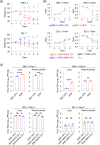The NSP6-L260F substitution in SARS-CoV-2 BQ.1.1 and XBB.1.16 lineages compensates for the reduced viral polymerase activity caused by mutations in NSP13 and NSP14
- PMID: 40358207
- PMCID: PMC12172475
- DOI: 10.1128/jvi.00656-25
The NSP6-L260F substitution in SARS-CoV-2 BQ.1.1 and XBB.1.16 lineages compensates for the reduced viral polymerase activity caused by mutations in NSP13 and NSP14
Abstract
Severe acute respiratory syndrome coronavirus 2 (SARS-CoV-2) Omicron variants emerged at the end of 2021, and their subvariants are still circulating worldwide. While changes in the S protein of these variants have been extensively studied, the roles of amino acid substitutions in non-structural proteins have not been fully revealed. In this study, we found that SARS-CoV-2 bearing the NSP6-L260F substitution emerged repeatedly when we generated several SARS-CoV-2 variants by reverse genetics or when we passaged SARS-CoV-2 isolated from clinical samples and that it was selected under cell culture conditions. Although this substitution has been detected in BQ.1.1 and XBB.1.16 that circulated in nature, its effect on viral properties is unclear. Here, we generated SARS-CoV-2 with or without the NSP6-L260F by reverse genetics and found that NSP6-L260F promotes virus replication in vitro and in vivo by increasing viral polymerase activity and enhancing virus pathogenicity in hamsters. We also identified disadvantageous substitutions, NSP13-M233I and NSP14-D222Y, that reduced BQ.1.1 and XBB.1.16 replication, respectively. These adverse effects were compensated for by NSP6-L260F. Our findings suggest the importance of NSP6-L260F for virus replication and pathogenicity and reveal part of the evolutionary process of Omicron variants.IMPORTANCEAlthough the properties of severe acute respiratory syndrome coronavirus 2 (SARS-CoV-2) Omicron variants continue to change through the acquisition of various amino acid substitutions, the roles of the amino acid substitutions in the non-structural proteins have not been fully explored. In this study, we found that the NSP6-L260F substitution enhances viral polymerase activity and is important for viral replication and pathogenicity. In addition, we found that the NSP13-M233I substitution in the BQ.1.1 lineage and the NSP14-D222Y substitution in the XBB.1.16 lineage reduce viral polymerase activity, and this adverse effect is compensated for by the NSP6-L260F substitution. Our results provide insight into the evolutionary process of SARS-CoV-2.
Keywords: COVID-19; SARS-CoV-2.
Conflict of interest statement
The authors declare no conflict of interest.
Figures





Similar articles
-
Convergent evolution in nucleocapsid facilitated SARS-CoV-2 adaptation for human infection.J Virol. 2025 Jul 22;99(7):e0209124. doi: 10.1128/jvi.02091-24. Epub 2025 Jun 12. J Virol. 2025. PMID: 40503915 Free PMC article.
-
Determinants of susceptibility to SARS-CoV-2 infection in murine ACE2.J Virol. 2025 Jun 17;99(6):e0054325. doi: 10.1128/jvi.00543-25. Epub 2025 May 12. J Virol. 2025. PMID: 40353671 Free PMC article.
-
A mutation in the coronavirus nsp13-helicase impairs enzymatic activity and confers partial remdesivir resistance.mBio. 2023 Aug 31;14(4):e0106023. doi: 10.1128/mbio.01060-23. Epub 2023 Jun 20. mBio. 2023. PMID: 37338298 Free PMC article.
-
Assessing the comparative effects of interventions in COPD: a tutorial on network meta-analysis for clinicians.Respir Res. 2024 Dec 21;25(1):438. doi: 10.1186/s12931-024-03056-x. Respir Res. 2024. PMID: 39709425 Free PMC article. Review.
-
The Role of TDP-43 in SARS-CoV-2-Related Neurodegenerative Changes.Viruses. 2025 May 19;17(5):724. doi: 10.3390/v17050724. Viruses. 2025. PMID: 40431734 Free PMC article. Review.
References
-
- Zhu N, Zhang D, Wang W, Li X, Yang B, Song J, Zhao X, Huang B, Shi W, Lu R, Niu P, Zhan F, Ma X, Wang D, Xu W, Wu G, Gao GF, Tan W, China Novel Coronavirus Investigating and Research Team . 2020. A novel coronavirus from patients with pneumonia in China, 2019. N Engl J Med 382:727–733. doi: 10.1056/NEJMoa2001017 - DOI - PMC - PubMed
-
- Ricciardi S, Guarino AM, Giaquinto L, Polishchuk EV, Santoro M, Di Tullio G, Wilson C, Panariello F, Soares VC, Dias SSG, Santos JC, Souza TML, Fusco G, Viscardi M, Brandi S, Bozza PT, Polishchuk RS, Venditti R, De Matteis MA. 2022. The role of NSP6 in the biogenesis of the SARS-CoV-2 replication organelle. Nature 606:761–768. doi: 10.1038/s41586-022-04835-6 - DOI - PMC - PubMed
MeSH terms
Substances
Supplementary concepts
Grants and funding
LinkOut - more resources
Full Text Sources
Medical
Miscellaneous

